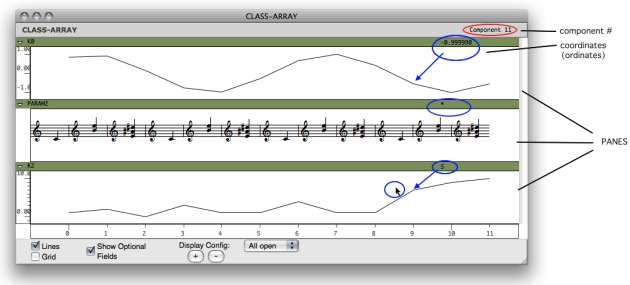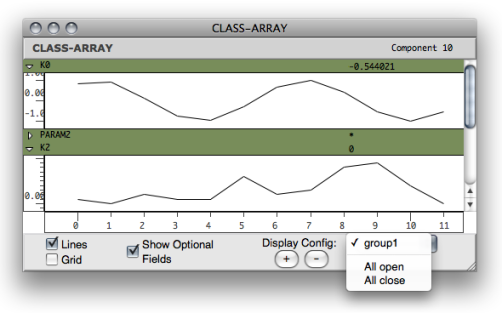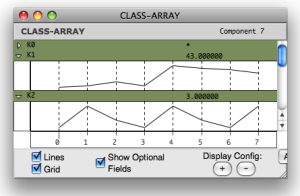| Navigation : Previous | Next |
Class-Array Editor
The class-array ** editor allows to visualize and edit - to a certain extent - the contents of a class-array object.
General Features
 The class-array editor.Zoom
The class-array editor.Zoom
In the class-array editor, rows are represented by a set of horizontal panes.
These panes can be :
- BPF -like views , if the component values are numbers
- list views , if the components are other types of objects or values .
The following values can be displayed at the top of the editor by hovering the mouse over a component :
- the number of the current component
- the values related to this component for each of the fields, such as coordinates, if values are available.
Displaying Options and Configuration
Palette
To zoom in/out on a selected region - a components subset - : use the ![]() and
and ![]() buttons of the palette.
buttons of the palette.

Options
- To display or hide the lines of BPFs, check the
Lineoption. - To apply a global grid to the editor, check the
Gridoption. - To show or hide the user-defined field , check the
Show Optional Fieldsoption.
All the fields of a simple class-array are user-defined. Consequently, all the rows of such arrays are hidden if this option is unchecked. Subclasses of class-arrays with “predefined” fields may remain visible.
Rows Configuration
![]()
Each row can be hidden or shown with a click on the triangle icons located on the upper left corner of each pane.
To save, recall or remove a given configuration, use the + and - buttons at the bottom of the editor.
To select a configuration, use the adjacent pop up menu, which contains all available or recorded configurations.

Edition
BPF-Like Rows
BPF -like rows offer some of the possibilities of BPF editors :
- hiding / showing lines
- moving points, in order to change the value(s) of the corresponding components.
Note: Points cannot me removed.

List Rows
List rows display the contents of every components, with various types of representations depending on the type of data.
Objects with an editor - BPFs , score objects, arrays, etc.- can be open by a double click and edited individually.
Limits of Array Editors
A big array may not represent all of its internal component values, in which case the internal components display may be automatically disabled.
Contents :
- OpenMusic Documentation
- OM User Manual
- Introduction
- System Configuration and Installation
- Going Through an OM Session
- The OM Environment
- Visual Programming I
- Visual Programming II
- Basic Tools
- Curves and Functions
- Array
- Class-Array Object
- Class-Array Editor
- Class-Array Tools
- TextFile
- Picture
- Score Objects
- Maquettes
- Sheet
- MIDI
- Audio
- SDIF
- Lisp Programming
- Reactive mode
- Errors and Problems
- OpenMusic QuickStart
| Navigation : Previous | Next |
